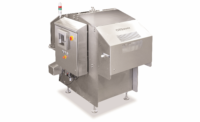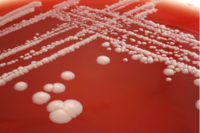Irradiation for Safer Food
This technology is an important weapon in the war against pathogens.
Microbial contamination remains a serious concern, and food manufacturers are turning to a growing list of interventions to control it. Irradiation is a powerful food-safety tool that can be applied to food in its final packaging, helping ensure the food’s safety prior to release into commerce.
The latest U.S. Department of Agriculture Food Safety and Inspection Service sampling data for ground beef show 0.32 percent positives for E.coli O157:H7. This might not seem like a lot, but the tens of billions of servings consumed annually in this country translate into tens of millions of servings starting with contaminated raw product. Cooking kills most of the pathogens, but even a low probability of failure can put sizeable numbers of consumers at risk.
Testing alone cannot solve this problem.
“Detection of contaminated product becomes more difficult as pathogen levels drop,” says Joseph Borsa, Ph.D., of Ottawa, Ontario, Canada-based MDS Nordion, “and such product can slip through even the most rigorous testing program.”
The only solution is to treat 100 percent of product to kill any pathogens that might be present, as is done in milk pasteurization. Irradiation can do this.
“Although not a ’silver bullet,’” says Borsa, “irradiation can serve as an excellent CCP in a manufacturer’s HACCP plan.”
The technology gradually is gaining consumer acceptance, according to Ron Eustice, executive director of the Minnesota Beef Council.
“Support for irradiated foods has more than doubled during the past decade,” says Eustice. “A 2003 study by Jefferson Davis Associates showed 68 percent of 396 respondents were aware of irradiation, and 78 percent thought irradiated ground beef was ‘a good thing.’”
Overcoming barriers
One barrier to wider use of irradiation, says Borsa, is logistics. Currently, many processors wishing to irradiate must ship product long distances to existing service providers. New plants, conveniently located to serve the meat industry, will allow more processors to take advantage of the technology.
Another major barrier is the lack of regulatory approval for irradiation of ready-to-eat foods that can harbor Listeria. U.S. Food & Drug Administration approval will allow manufacturers to use irradiation to further enhance the safety of these products. As for any other new product, consumer education plays an important role in consumer acceptance.
“The virtually unanimous support from the health, scientific and academic communities must be publicized,” stresses Eustice. “The consequences of foodborne illness must not be underestimated or trivialized,” he adds.
MDS Nordion builds irradiators specially designed to process meat and poultry to exacting standards. The company’s Centurion gamma-ray technology offers high-volume processing at a low cost, and its Palletron technology allows x-ray processing of pallet loads of product. Such systems installed in cold storage centers could alleviate many of the logistics difficulties.
Eustice expects meat irradiation to one day become as common as pasteurization.
Eustice expects meat irradiation to one day become as common as pasteurization.
“Today, with the availability of pasteurized eggs, it would be very difficult to defend a restaurant, school, or care provider that chose to serve non-pasteurized eggs that resulted in a salmonella outbreak,” he says. “We will come to a similar situation with irradiated ground beef.” NP
MDS Nordion, phone (613) 592-2790, fax (613) 592-0224, e-mail foodsafety@mds.nordion.com, or visit www.mds.nordion.com
MDS Nordion, phone (613) 592-2790, fax (613) 592-0224, e-mail foodsafety@mds.nordion.com, or visit www.mds.nordion.com




